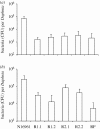An experimental study of the population and evolutionary dynamics of Vibrio cholerae O1 and the bacteriophage JSF4
- PMID: 20538647
- PMCID: PMC2981924
- DOI: 10.1098/rspb.2010.0651
An experimental study of the population and evolutionary dynamics of Vibrio cholerae O1 and the bacteriophage JSF4
Abstract
Studies of Vibrio cholerae in the environment and infected patients suggest that the waning of cholera outbreaks is associated with rise in the density of lytic bacteriophage. In accordance with mathematical models, there are seemingly realistic conditions where phage predation could be responsible for declines in the incidence of cholera. Here, we present the results of experiments with the El Tor strain of V. cholerae (N16961) and a naturally occurring lytic phage (JSF4), exploring the validity of the main premise of this model: that phage predation limits the density of V. cholerae populations. At one level, the results of our experiments are inconsistent with this hypothesis. JSF4-resistant V. cholerae evolve within a short time following their confrontation with these viruses and their populations become limited by resources rather than phage predation. At a larger scale, however, the results of our experiments are not inconsistent with the hypothesis that bacteriophage modulate outbreaks of cholera. We postulate that the resistant bacteria that evolved play an insignificant role in the ecology or pathogenicity of V. cholerae. Relative to the phage-sensitive cells from whence they are derived, the evolved JSF4-resistant V. cholerae have fitness costs and other characters that are likely to impair their ability to compete with the sensitive cells in their natural habitat and may be avirulent in human hosts. The results of this in vitro study make predictions that can be tested in natural populations of V. cholerae and cholera-infected patients.
Figures




Similar articles
-
Self-limiting nature of seasonal cholera epidemics: Role of host-mediated amplification of phage.Proc Natl Acad Sci U S A. 2005 Apr 26;102(17):6119-24. doi: 10.1073/pnas.0502069102. Epub 2005 Apr 13. Proc Natl Acad Sci U S A. 2005. PMID: 15829587 Free PMC article.
-
Genesis of variants of Vibrio cholerae O1 biotype El Tor: role of the CTXphi array and its position in the genome.Microbiology (Reading). 2003 Jan;149(Pt 1):89-97. doi: 10.1099/mic.0.25599-0. Microbiology (Reading). 2003. PMID: 12576583
-
The population and evolutionary dynamics of Vibrio cholerae and its bacteriophage: conditions for maintaining phage-limited communities.Am Nat. 2011 Dec;178(6):715-25. doi: 10.1086/662677. Epub 2011 Nov 1. Am Nat. 2011. PMID: 22089867
-
Inland cholera in freshwater environs of north India.Vaccine. 2020 Feb 29;38 Suppl 1:A63-A72. doi: 10.1016/j.vaccine.2019.06.038. Epub 2019 Jul 3. Vaccine. 2020. PMID: 31279566 Review.
-
Whole-genome sequence comparisons reveal the evolution of Vibrio cholerae O1.Trends Microbiol. 2015 Aug;23(8):479-89. doi: 10.1016/j.tim.2015.03.010. Epub 2015 Apr 24. Trends Microbiol. 2015. PMID: 25913612 Review.
Cited by
-
What Can Phages Tell Us about Host-Pathogen Coevolution?Int J Evol Biol. 2012;2012:396165. doi: 10.1155/2012/396165. Epub 2012 Nov 18. Int J Evol Biol. 2012. PMID: 23213618 Free PMC article.
-
Constructing and Characterizing Bacteriophage Libraries for Phage Therapy of Human Infections.Front Microbiol. 2019 Nov 12;10:2537. doi: 10.3389/fmicb.2019.02537. eCollection 2019. Front Microbiol. 2019. PMID: 31781060 Free PMC article.
-
Bacteria-phage coevolution as a driver of ecological and evolutionary processes in microbial communities.FEMS Microbiol Rev. 2014 Sep;38(5):916-31. doi: 10.1111/1574-6976.12072. Epub 2014 Mar 27. FEMS Microbiol Rev. 2014. PMID: 24617569 Free PMC article. Review.
-
Coevolution can reverse predator-prey cycles.Proc Natl Acad Sci U S A. 2014 May 20;111(20):7486-91. doi: 10.1073/pnas.1317693111. Epub 2014 May 5. Proc Natl Acad Sci U S A. 2014. PMID: 24799689 Free PMC article.
-
Phage therapy: Should bacterial resistance to phages be a concern, even in the long run?Bacteriophage. 2013 Jan 1;3(1):e24219. doi: 10.4161/bact.24219. Bacteriophage. 2013. PMID: 23819105 Free PMC article.
References
-
- Ali A., Rashid M. H., Karaolis D. K.2002High-frequency rugose exopolysaccharide production by Vibrio cholerae. Appl. Environ. Microbiol. 68, 5773–5778 (doi:10.1128/AEM.68.11.5773-5778.2002) - DOI - PMC - PubMed
-
- Beyhan S., Yildiz F. H.2007Smooth to rugose phase variation in Vibrio cholerae can be mediated by a single nucleotide change that targets c-di-GMP signalling pathway. Mol. Microbiol. 63, 995–1007 (doi:10.1111/j.1365-2958.2006.05568.x) - DOI - PubMed
-
- Bohannan B. J. M., Lenski R. E.2000Linking genetic change to community evolution: insights from studies of bacteria and bacteriophage. Ecol. Lett. 3, 362–377 (doi:10.1046/j.1461-0248.2000.00161.x) - DOI
-
- Brockhurst M. A., Buckling A., Rainey P. B.2005The effect of a bacteriophage on diversification of the opportunistic bacterial pathogen, Pseudomonas aeruginosa. Proc. R. Soc. B 272, 1385–1391 (doi:10.1098/rspb.2005.3086) - DOI - PMC - PubMed
-
- Buckling A., Rainey P. B.2002Antagonistic coevolution between a bacterium and a bacteriophage. Proc. R. Soc. Lond. B 269, 931–936 (doi:10.1098/rspb.2001.1945) - DOI - PMC - PubMed
Publication types
MeSH terms
Grants and funding
LinkOut - more resources
Full Text Sources
Medical

